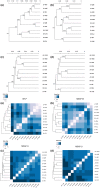Epigenetic architecture of Pseudotaxus chienii: Revealing the synergistic effects of climate and soil variables
- PMID: 37701023
- PMCID: PMC10493196
- DOI: 10.1002/ece3.10511
Epigenetic architecture of Pseudotaxus chienii: Revealing the synergistic effects of climate and soil variables
Abstract
Whether conifers can withstand environmental changes especially temperature fluctuations has been controversial. Epigenetic analysis may provide new perspectives for solving the issue. Pseudotaxus chienii is an endangered gymnosperm species endemic to China. In this study, we have examined the genetic and epigenetic variations in its natural populations aiming to disentangle the synergistic effects of climate and soil on its population (epi)genetic differentiation by using amplified fragment length polymorphism (AFLP) and methylation-sensitive AFLP (MSAP) techniques. We identified 23 AFLP and 26, 7, and 5 MSAP outliers in P. chienii. Twenty-one of the putative adaptive AFLP loci were found associated with climate and/or soil variables including precipitation, temperature, K, Fe, Zn, and Cu, whereas 21, 7, and 4 MSAP outliers were significantly related to precipitation of wettest month (Bio13), precipitation driest of month (Bio14), percent tree cover (PTC), and soil Fe, Mn, and Cu compositions. Total precipitation and precipitation in the driest seasons were the most influential factors for genetic and epigenetic variation, respectively. In addition, a high full-methylation level and a strong correlation between genetic and epigenetic variation were detected in P. chienii. Climate is found of greater importance than soil in shaping adaptive (epi)genetic differentiation, and the synergistic effects of climate and climate-soil variables were also observed. The identified climate and soil variables should be considered when applying ex situ conservation.
Keywords: MSAP; Pseudotaxus chienii; climate and soil variables; population epigenetic variation; synergistic effects.
© 2023 The Authors. Ecology and Evolution published by John Wiley & Sons Ltd.
Conflict of interest statement
The authors declare no conflicts of interest.
Figures







Similar articles
-
EST-SSR-based landscape genetics of Pseudotaxus chienii, a tertiary relict conifer endemic to China.Ecol Evol. 2021 Jun 15;11(14):9498-9515. doi: 10.1002/ece3.7769. eCollection 2021 Jul. Ecol Evol. 2021. PMID: 34306638 Free PMC article.
-
Population transcriptomic sequencing reveals allopatric divergence and local adaptation in Pseudotaxus chienii (Taxaceae).BMC Genomics. 2021 May 26;22(1):388. doi: 10.1186/s12864-021-07682-3. BMC Genomics. 2021. PMID: 34039278 Free PMC article.
-
Methylation data from Pseudotaxus chienii obtained using methylation-dependent restriction-site associated DNA sequencing.Data Brief. 2018 Jun 26;19:1556-1559. doi: 10.1016/j.dib.2018.06.045. eCollection 2018 Aug. Data Brief. 2018. PMID: 30229028 Free PMC article.
-
Epigenomics in stress tolerance of plants under the climate change.Mol Biol Rep. 2023 Jul;50(7):6201-6216. doi: 10.1007/s11033-023-08539-6. Epub 2023 Jun 9. Mol Biol Rep. 2023. PMID: 37294468 Review.
-
Application of the MSAP Technique to Evaluate Epigenetic Changes in Plant Conservation.Int J Mol Sci. 2020 Oct 10;21(20):7459. doi: 10.3390/ijms21207459. Int J Mol Sci. 2020. PMID: 33050382 Free PMC article. Review.
References
-
- Abdo, A. S. S. , Rawi, C. S. M. , Ahmad, A. , & Madrus, M. R. (2013). Biodiversity of stream insects in the Malaysian peninsula: Spatial patterns and environmental constraints. Ecological Entomology, 38, 238–249. 10.1111/een.12013 - DOI
-
- Agapow, P. M. , & Burt, A. (2001). Indices of multilocus linkage disequilibrium. Molecular Ecology Notes, 1, 101–102. 10.1046/j.1471-8278.2000.00014.x - DOI
Associated data
LinkOut - more resources
Full Text Sources

